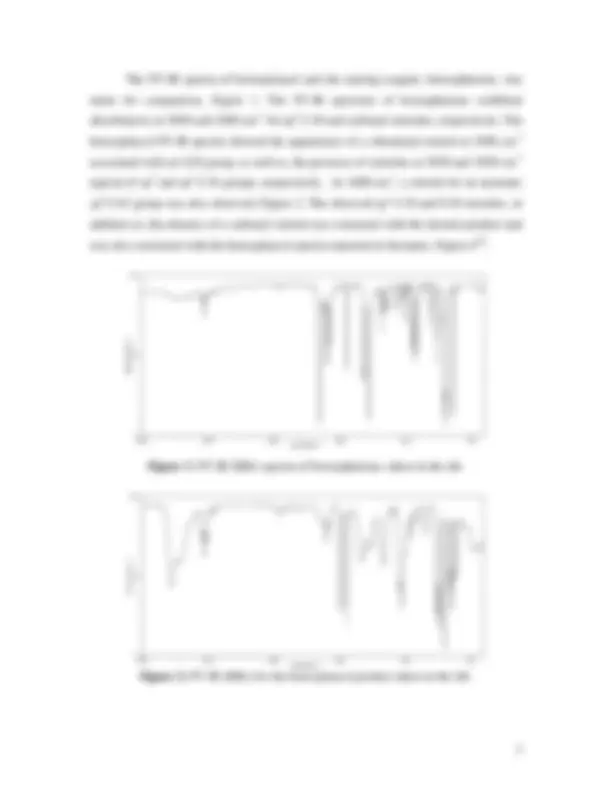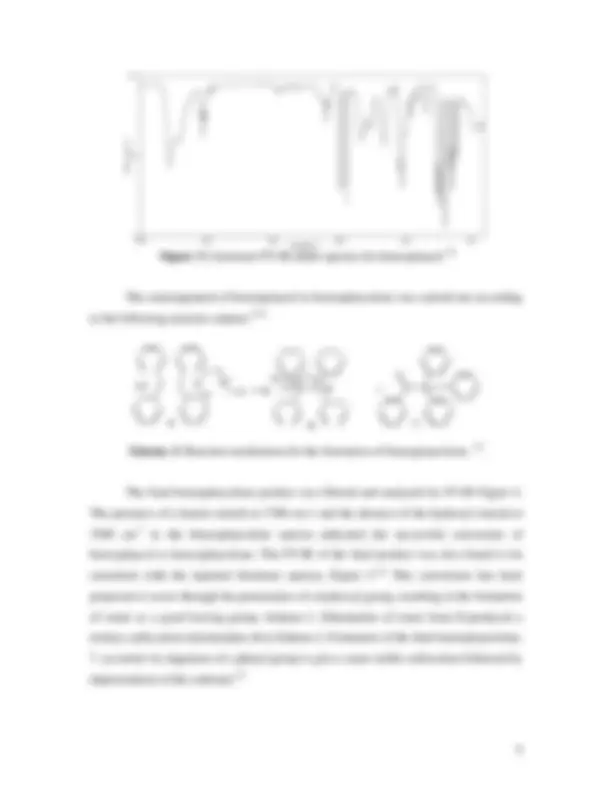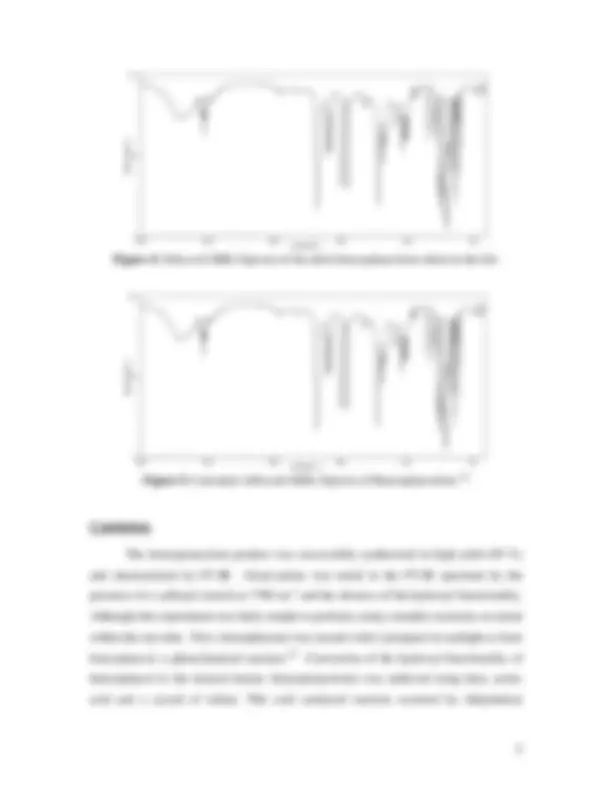





Study with the several resources on Docsity

Earn points by helping other students or get them with a premium plan


Prepare for your exams
Study with the several resources on Docsity

Earn points to download
Earn points by helping other students or get them with a premium plan
Community
Ask the community for help and clear up your study doubts
Discover the best universities in your country according to Docsity users
Free resources
Download our free guides on studying techniques, anxiety management strategies, and thesis advice from Docsity tutors
This experiment was designed to provide experience in preparing compounds using a two-step synthetic scheme.
Typology: Lab Reports
1 / 6

This page cannot be seen from the preview
Don't miss anything!





On special offer
Joe Student August 19, 2010 Organic Chemistry Laboratory I (Chem 326-01) Instructor: Dr. Know It All Report 1
Synthesis of Benzopinacolone from benzophenone.
Introduction:
This experiment was designed to provide experience in preparing compounds using a two-step synthetic scheme. The first step is a light-catalyzed radical reaction and the second-step is an elimination/rearrangement reactions. The first step is the conversion of benzophenone to bezopinacol using a photochemical reaction. Photochemical reactions often involve free radical species which are compounds with an unpaired electron. Free radical compounds are very reactive and are involved in reactions such as hydrogen abstraction, radical coupling, and polymerizations. The second step of this reaction series is the acid catalyzed dehydration of benzopinacol followed by rearrangement to benzopinacolone. This reaction illustrates the concept of carbocation rearrangement to a more stable carbocation. In this reaction, a tertiary carbocation rearranges to a more stable carbocation.
Experimental:
Synthesis of Benzopinacol:[3]
To a clean test tube were added benzophenone (2.0 g, 0.011 mol), 2-propanol ( mL), and concentrated acetic acid (1 drop). The tube was then sealed with a parafilm- covered cork. The cork was secured to the test tube using more parafilm and wire. The test tube was taken to the roof of the chemistry building and exposed to sunlight for 5 days. The resulting crystalline product, benzopinacol, was collected and air dried using a Büchner funnel. The white crystalline product was analyzed by FT-IR using a PE 1600 Series spectrometer. Yield = 2.9g (72.5 %); FT-IR (KBr): 3431 cm-1^ (strong; O-H), 3087-2937 cm- (medium; aromatic and aliphatic C-H), 1597 cm-1^ (strong; aromatic C=C), 1581 cm- (strong; aromatic C=C), 1086 cm-1^ (strong; C-O).
Synthesis of Benzopinacolone:[3]
To a clean test tube was added benzopinacol (100 mg, 2.7 x 10-4^ mol), 100% acetic acid (500 mL), followed by a single crystal of iodine. The mixture was heated over a micro-burner until a solution was formed and then refluxed for five additional minutes. After cooling to room temperature, the white precipitate, benzopinacolone, was collected by vacuum filtration (Büchner funnel) and washed free of iodine using cold ethanol. The white benzopinacolone crystals were air-dried and analyzed by FT-IR using a PE 1600 Series spectrometer. Yield = 90 mg (95 %); FT-IR (KBr): 3087-3018 cm-1^ (medium; aromatic C= C-H ), 1670 cm-1^ (strong; C=O), 1581 cm-1^ (strong; aromatic C=C), 1320 cm-1^ (strong; C= C-H ).
Results and Discussion:
Benzophenone is known to react with 2-propanol to form benzopinacol in the presence of sunlight. Thus, one gram of benzophenone was dissolved in a test tube containing 2-propanol and 100% acetic acid. The test tube was sealed to prevent any unwanted chemical reactions with the air and then exposed to sunlight on the roof of the chemistry building for several days. During this time, crystals of the benzopinacol formed according to the mechanism shown in Scheme 1.[1]
Scheme 1: Reaction mechanism for the synthesis of benzopinacol from benzophenone.[1]
Figure 3: Literature FT-IR (KBr) spectra for benzopinacol.[2]
The rearrangement of benzopinacol to benzopinacolone was carried out according to the following reaction scheme:[1,3]
Scheme 2: Reaction mechanism for the formation of benzopinacolone. [1]
The final benzopinacolone product was filtered and analyzed by FT-IR Figure 4. The presence of a ketone stretch at 1700 cm-1 and the absence of the hydroxyl stretch at 3500 cm-1^ in the benzopinacolone spectra indicated the successful conversion of benzopinacol to benzopinacolone. The FT-IR of the final product was also found to be consistent with the reported literature spectra, Figure 5.[2]^ This conversion has been proposed to occur through the protonation of a hydroxyl group, resulting in the formation of water as a good leaving group, Scheme 2. Elimination of water from 5 produced a tertiary carbocation intermediate, 6 in Scheme 2. Formation of the final benzopinacolone, 7, occurred via migration of a phenyl group to give a more stable carbocation followed by deprotonation of the carbonyl.[3]
Figure 4: Infra-red (KBr) Spectra of the dried benzopinacolone taken in the lab.
Figure 5: Literature Infra-red (KBr) Spectra of Benzopinacolone.[2]
Conclusion:
The benzopinacolone product was successfully synthesized in high yield (95 %) and characterized by FT-IR. Good purity was noted in the FT-IR spectrum by the presence of a carbonyl stretch at 1700 cm-1^ and the absence of the hydroxyl functionality. Although this experiment was fairly simple to perform, many complex reactions occurred within the test tube. First, benzophenone was reacted with 2-propanol in sunlight to form benzopinacol, a photochemical reaction.[3]^ Conversion of the hydroxyl functionality of benzopinacol to the desired ketone (benzopinacolone) was achieved using heat, acetic acid and a crystal of iodine. This acid catalyzed reaction occurred by dehydration